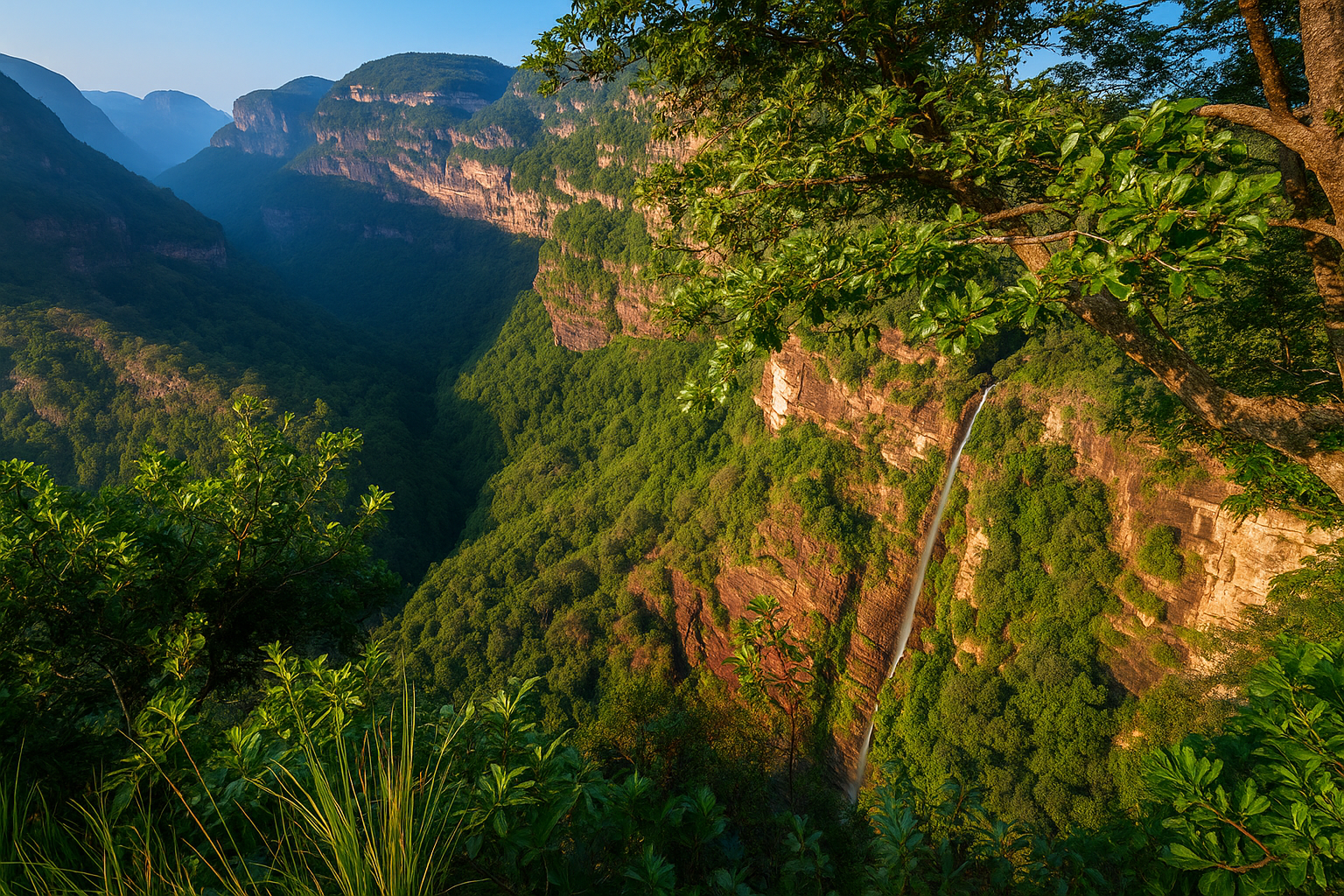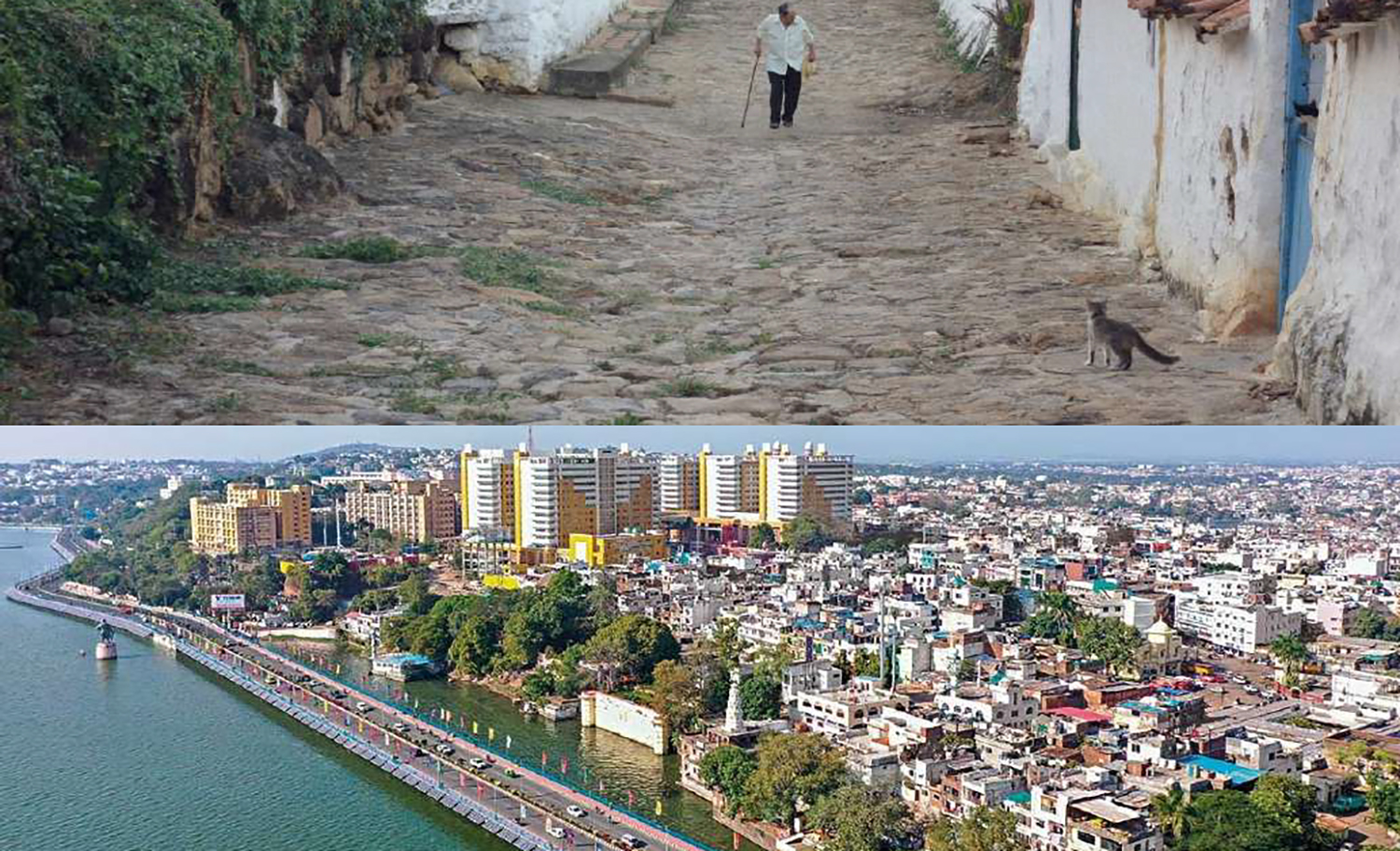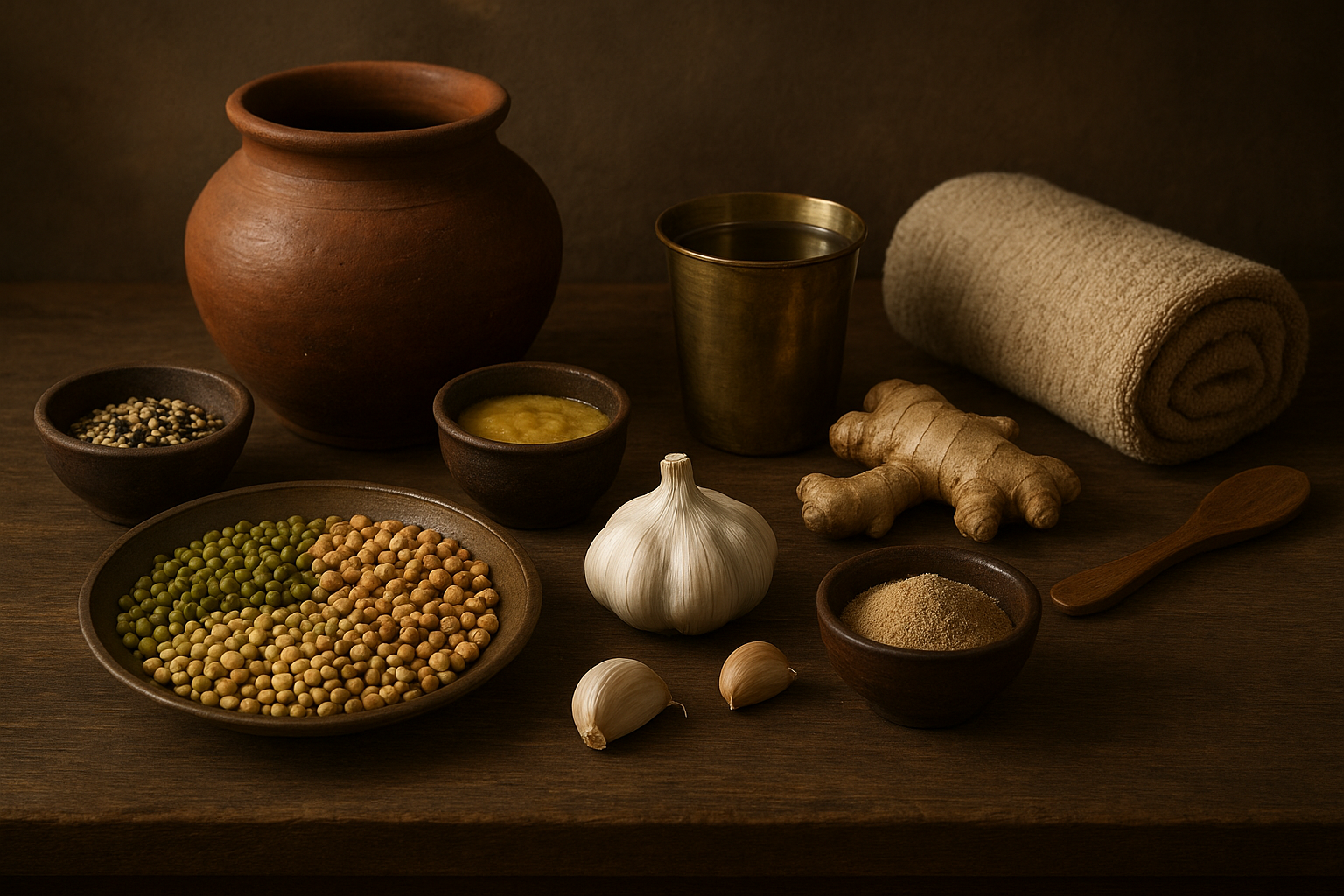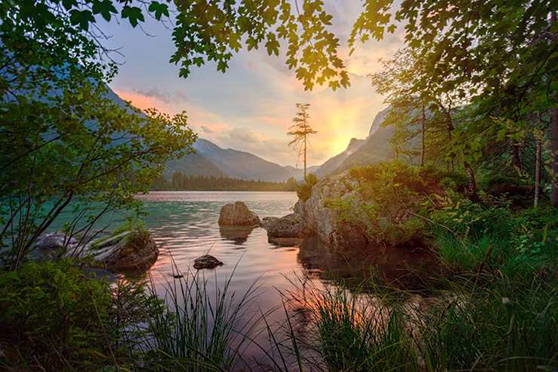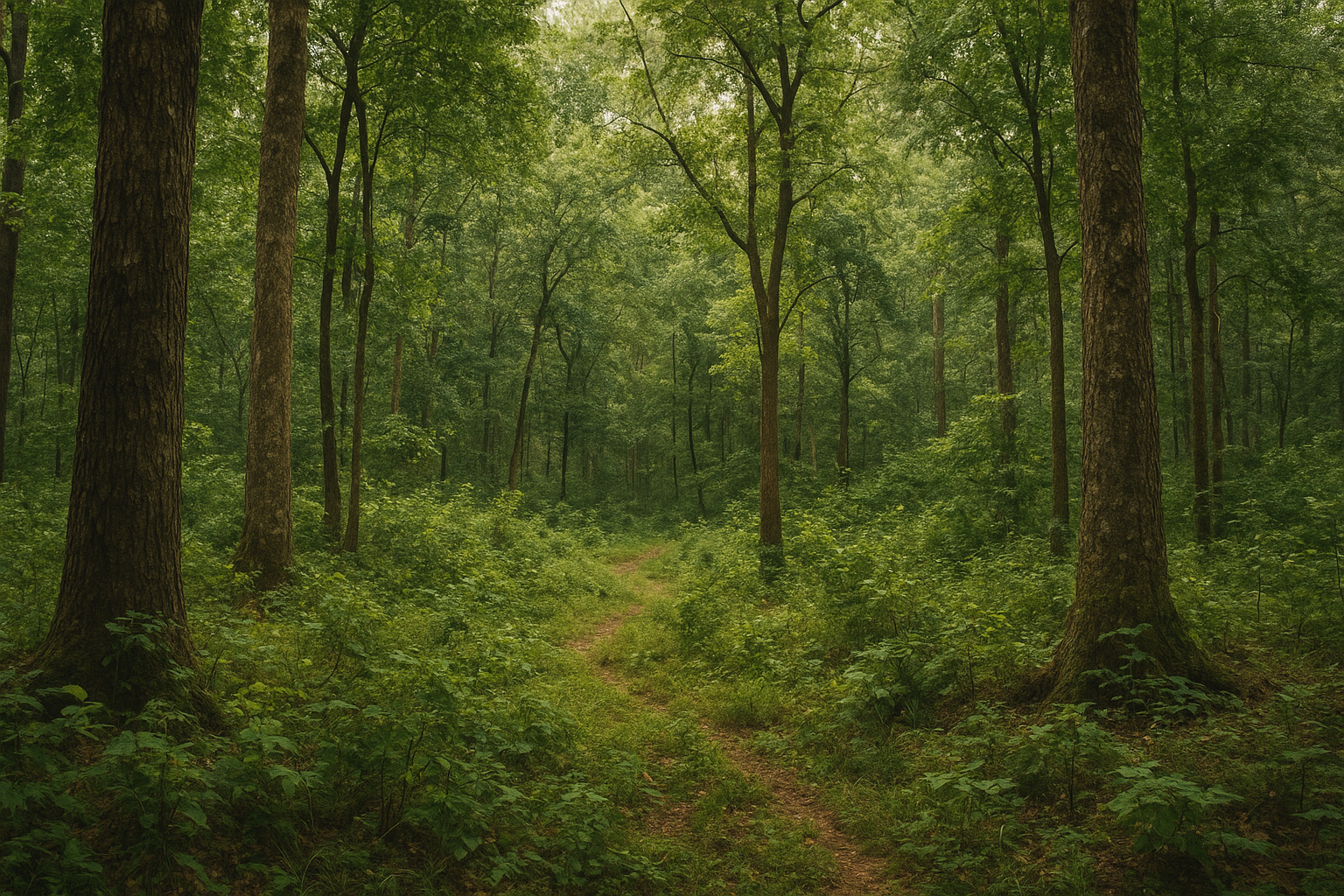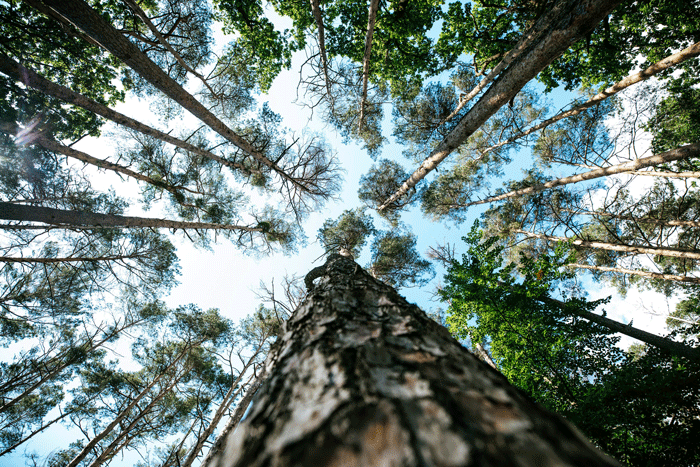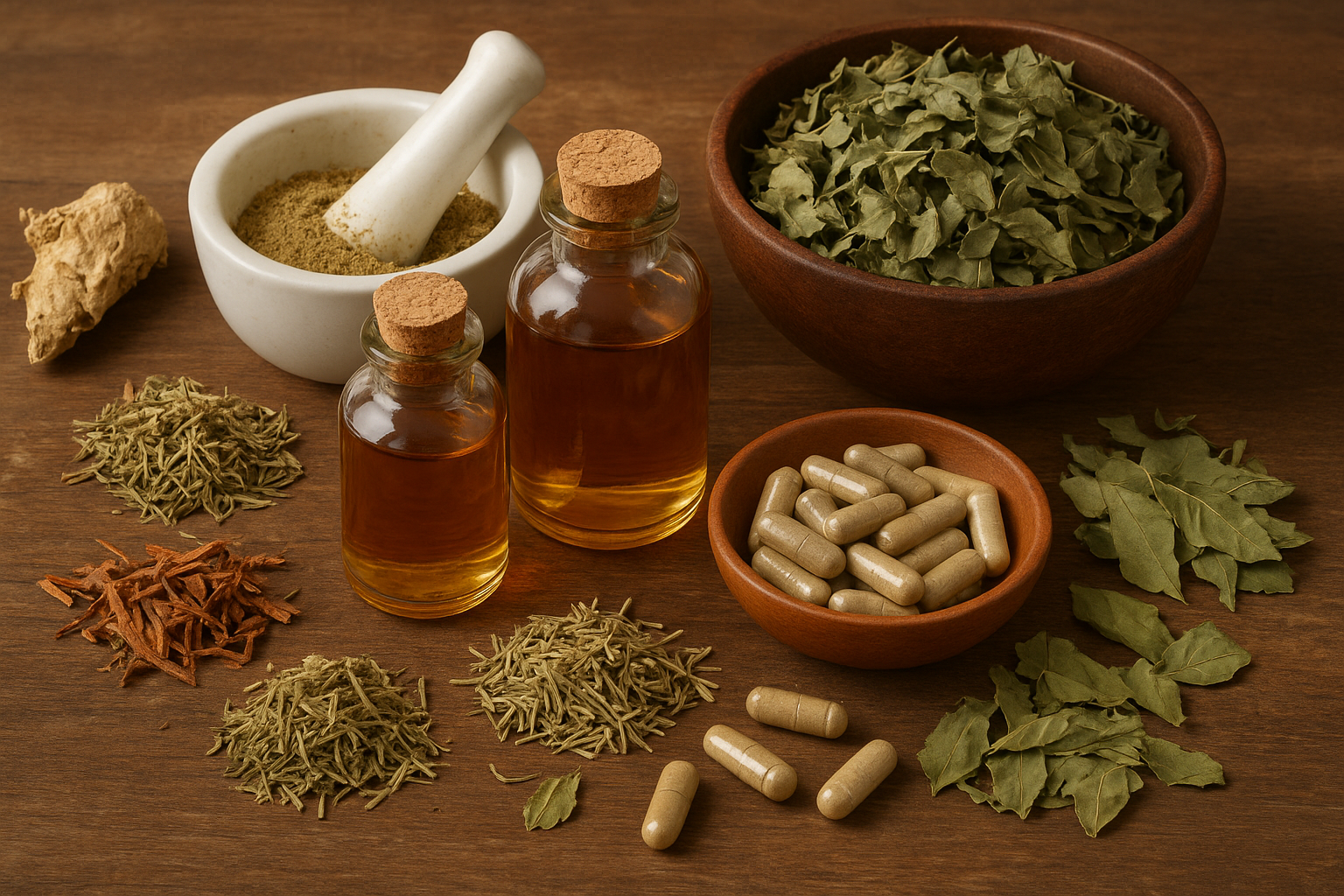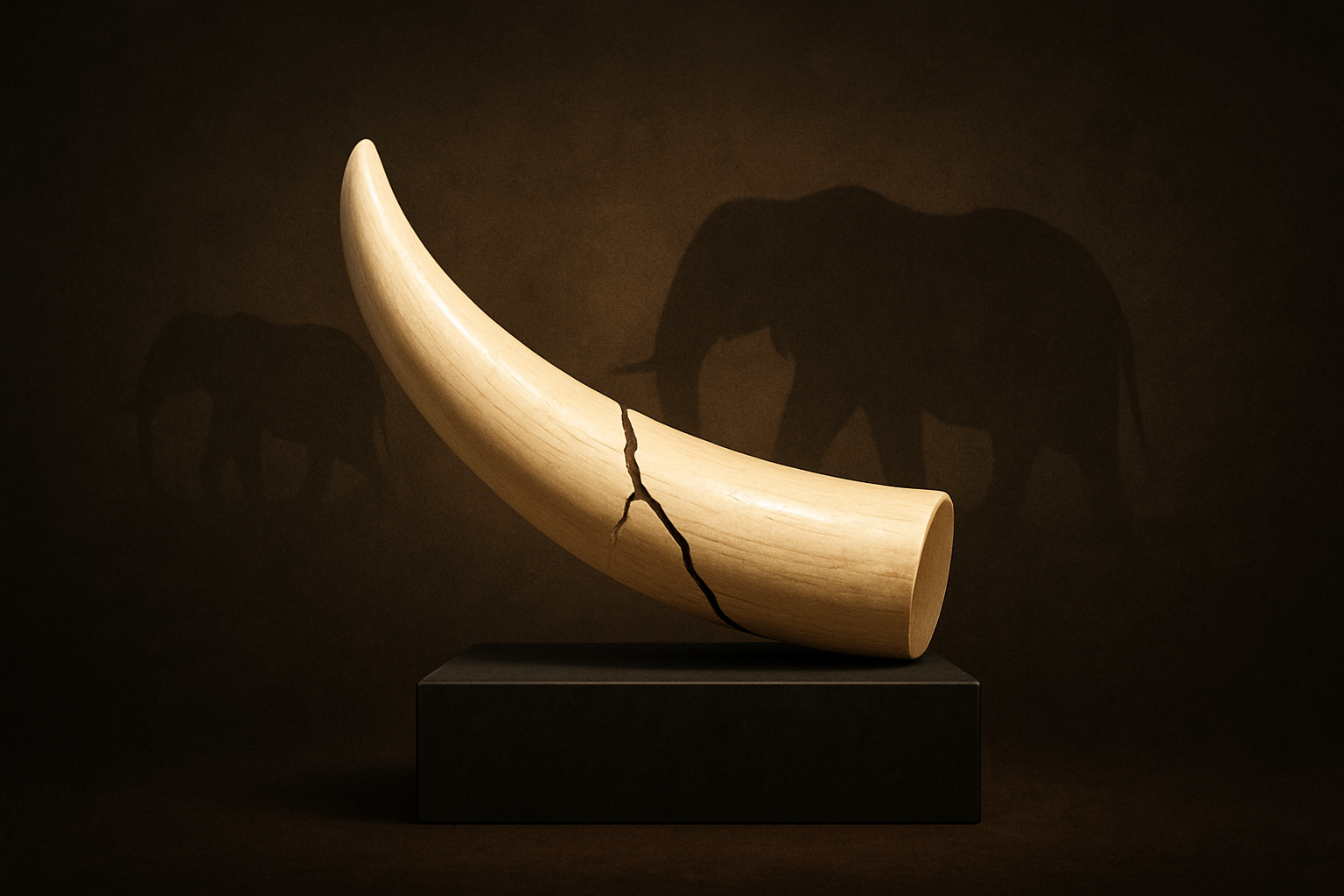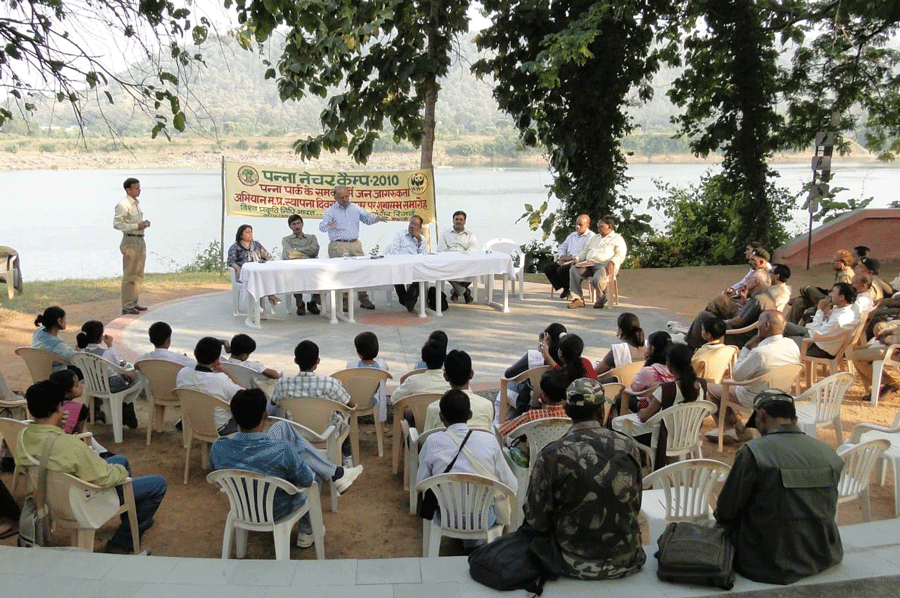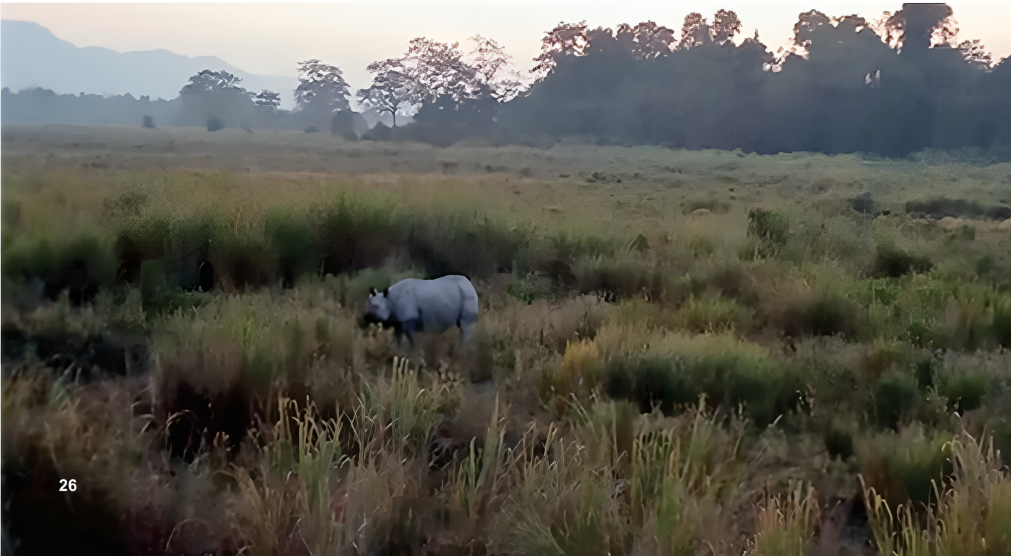Kazi Trip Travelogue
E ven before we reached the main gates, we caught sight of a lumbering grey mass at 9 o clock & another about 70 yards behind. We were breathtakingly to catch our first sighting of the Great One Horned Rhino. We were viewing the marshy fields of Kaziranga National Park & Tiger reserve on the eastern wing of Assam, a UNESCO world heritage site. Having toured a number of Tiger reserves our wishful thinking was to see the Great One Horned Rhino. We had an unsuccessful attempt at “Jaldapara National Park’ even after gypsy & elephant rides. We were determined & hopeful on this trip & wished to see these gentle giants who are now numbered over 2500 at Kaziranga.
As necessity would have it, my family tried fervently to come to a common program, but slipped up again & again. Elder son Dr Rajaskhekhar is working with an NGO, based at Pune, working on Human Elephant conflict in M.P. He is also touring south India, at Nagarhole & Kali Tiger Reserves, exploring possibilities for the same. Younger son Vijayshekhar, A.P. in Bio-technology at a renowned Institution was the safest bet. He had managed his vacation in the Christmas – New Year period methodically. Wife Dr Krishna principal of a C.B.S.E. school assured us she would be available in the same time. I, a doctor with N.H.M. M.P. squeezed in the few days with grant of superiors.
Our contact in Guwahati was Col Dr Sajal Sen, engaged presently in designing a new-tech hospital with association of IIT Guwahati. Train timings were not exactly convenient & flights touching New Delhi in this season were ruled out. The only option was a road trip, which, though exhausting, held the promise of discovering new places & peoples. It was decided that the three of us, sans Raja, would make the road trip while he would arrive & depart by flight.
On the chilly morning of 24.12.’24, we set out with our Cabbie, Hemant in his spotless white Swift Desire. We commenced our trip after prayers & making the auspicious ‘Swastik’ on the vehicle. The powerful engine ate up the miles as we caught sight of Ma ‘Sharda Devi’ hill at Maihar, beyond Katni. Routing now towards Rewa we crossed the division headquarters & broke for lunch at a garden resort. Not much to speak of but provided an excellent cuisine in a green ambience. We pushed further on to cross to U.P. over Mirzapur, the fabled land of carpets, to reach Buxar, known as mini Kashi, on the banks of the Ganges.
Buxar’s first cut impression was the distinctive ‘Bhojpuri’ dialect & the stalls of ‘Litti Chokha’, a delicious dish said to be savoured by Sri Ram himself. The city has left an indelible print in Indian history, made by the 1764 ‘Battle of Buxar’. The British, led by Major Munro defeated a larger combined opposition of Indian states, to stamp British authority in eastern India. The name Buxar is said to be derived from ‘Vyaghrasar’, a holy tank which is said to hold many magical powers.
As a largely sleepy town we could bunk easily in a centrally located lodge which excelled itself with courteous behavior & a very palatable dinner. With a few generous pots of steaming tea we managed to hit the road early & made for Siliguri the ancestral home of my maternal in-laws. My wife had spent most vacations there & was really looking forward to meet her uncles & aunts.
Bye-passing Patna, through Chhapra, we arrived at Muzaffarpur, a city of myriad cultures & cuisines: here people spoke Hindi, with touches of Urdu & Maithili. The famed ‘Maghai’ betel leaf’ along with ‘Litchi’ fruit have earned Muzaffarpur the G.I. tag. The real Indian versions of ‘Momos’ are served here, made from rice flour & lentils served with a curried paste, called ‘Dal-peetha’. The famous & delicious ‘Champaran Handi Mutton’ is originally a product of this region.
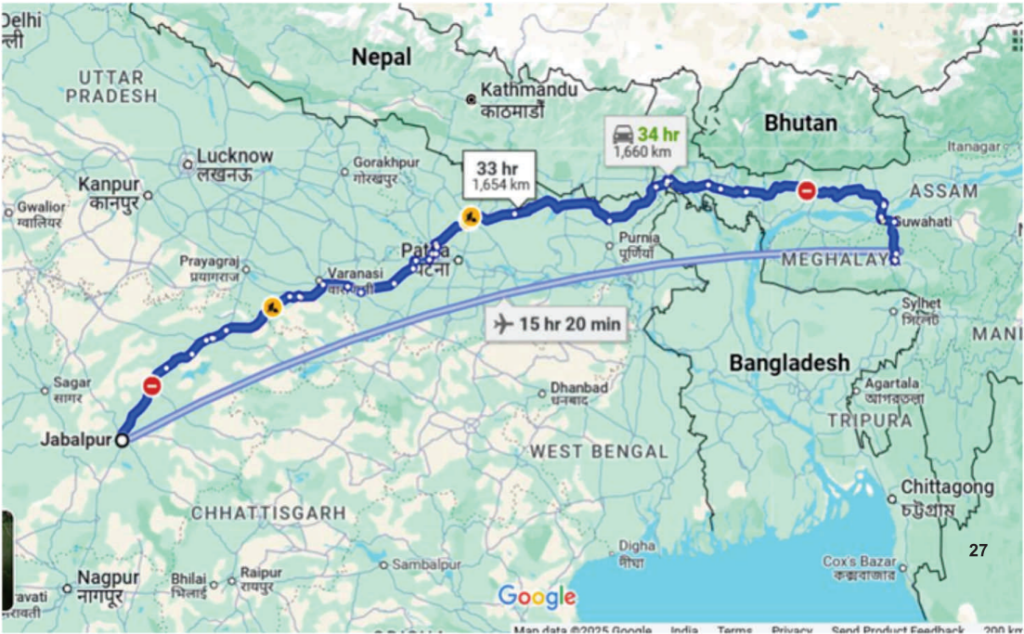
We were to reach Siliguri, twin counterpart city of Jailpaiguri, on Christmas. Christmas is celebrated with much pomp & fervor in all major cities of West Bengal. To reach our destination we faced many traffic diversions to accommodate the cheerful multitude. The place was alive with Santa dresses, & houses, chapels’ previous occasion we had made Siliguri our hub & spoked out to Darjeeling, ‘Jaldapara National Park, Sikkim & the Natu-la pass on the Old Silk Route connecting China. From here onwards towards Guwahati we were to experience a vast difference in people, cultures, cuisines & geography. We had left behind the vast Indo-Gangetic plains & were now in the confines of the Himalayan foothills.
After a scratch breakfast with Darjeeling tea & packed stuffed flatbreads we set off for Guwahati. When we broke for tea we discovered that the Assamese preferred to speak Hindi over Bengali, which is actually quite similar. We arrived at Bongaigaon in time for lunch & were introduced to another variation of cuisine. One is supposed to order a ‘Rice-plate’ with fish or chicken & are treated to a host of complimentary dishes, which included lentils, a gravy vegetable, some fritters, a leafy vegetable preparation & a paste of some herbs; overall a delicious meal.
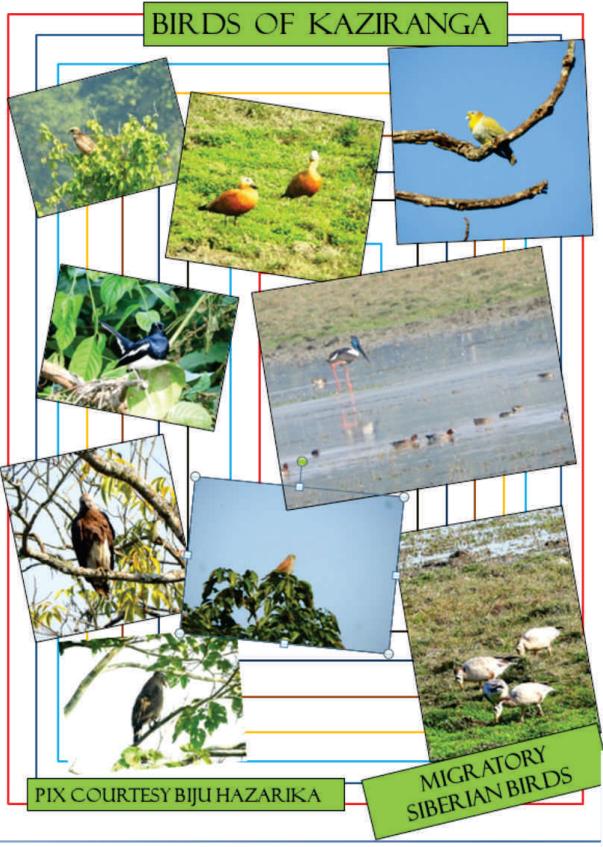
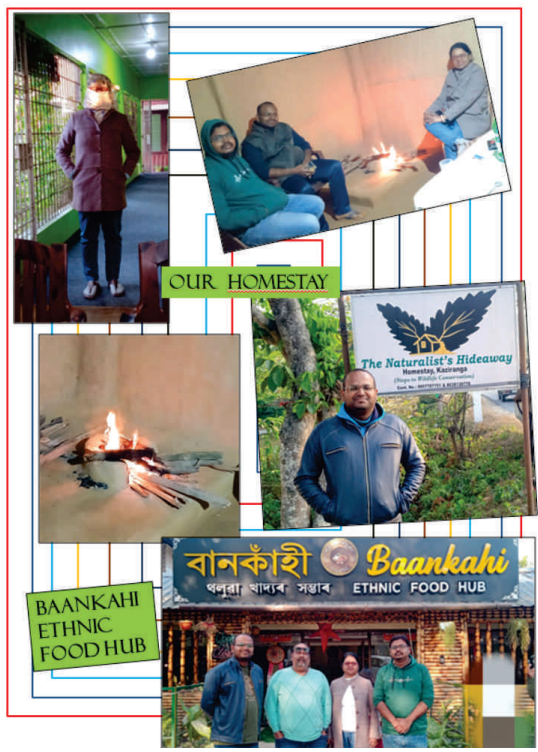
Guwahati is a pulsating vibrating city on the banks of the Bramhaputra, the flagship of North east India; a bustling business centre & educational hub hosting the A.I.I.M.S. & the I.I.T. The city reflects a fusion of religion, culture & nature. Apart from the Himalayas, the Shivalik range, locally called the ‘Cachar’ or ‘Churia’ hills, dominate the north-eastern skyline. Our churches & streets bursting with colour in every direction. Trans-street lightings were a real spectacle to watch.
My maternal in-laws home housed coconut trees the produce of which was commercially managed. Also within the campus were plants of ‘Bay’ leaves & trees whose bark is separated as ‘Cinnamon’. We settled down among greetings & were served traditional food, snacks & Darjeeling tea. The notable change in diet now included the distinctive spices of the region, mainly Mustard whose numerous lemon yellow & ochre fields we had passed on the way.
Inclusion of a variety of fish & lobster prawn dishes were a gourmet’s delight. Darjeeling tea & its variants were lovely, served as liquor or with milk & had a grand delectable fragrance. ‘Veiled’ potato or radish fritters were a treat where the vegetables are so sliced to resemble a ‘Net’ or ‘Veil’ & marinated with curds before frying.
Siliguri is a hill station on the banks of the river Mahananda from where we could catch a glimpse of Kanchanjunga from the rooptop of our lodging. Siliguri has been labeled as the ‘Gateway to the North East’. On a order, like the table-shuffling of cards. Efficiently our bags & purses were checked & contraband like cigarettes & lighters removed. Within ten minutes into the park we came upon our first sighting, two hog deer gently grazing. Hog deer form the majority of the ungulates in the region. Many different kinds of birds were gently picking up grubs. We stopped to feed our senses the serenity of the park where the marsh lands rolled on to the tall grass & the hills beyond.
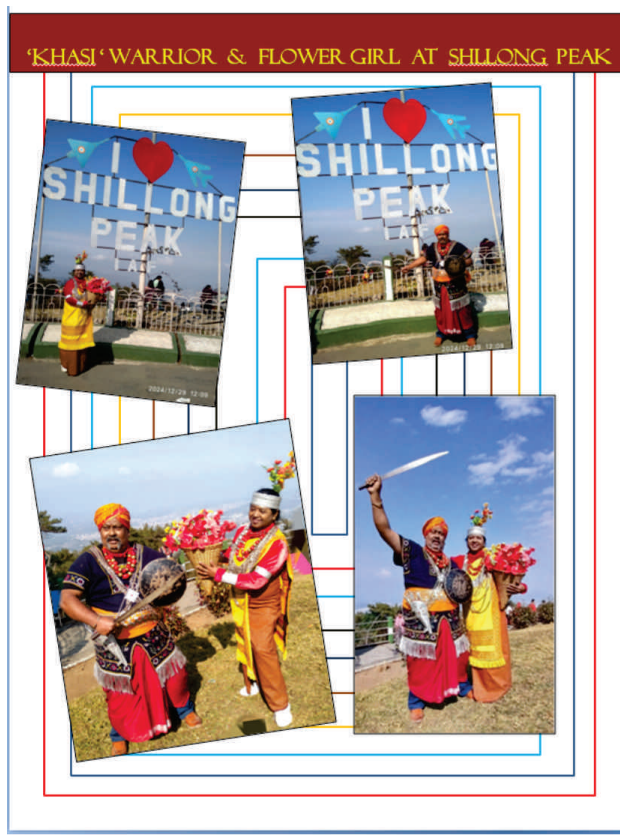
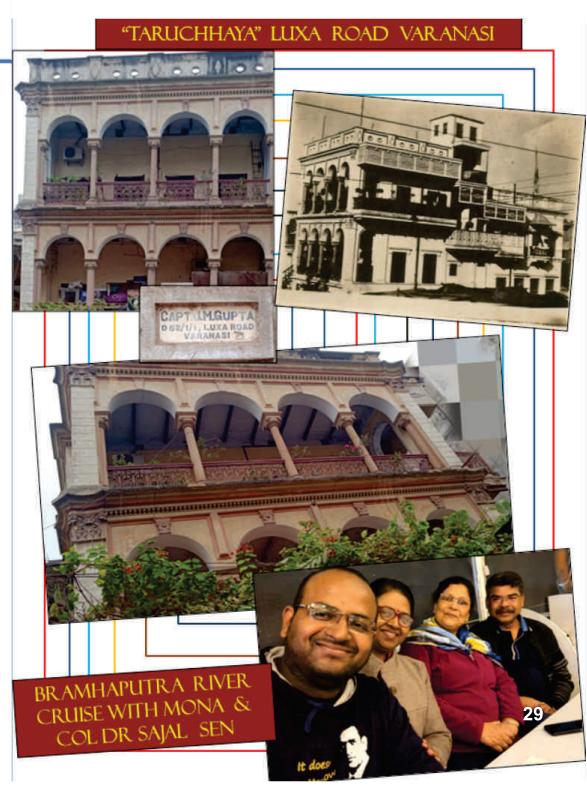
Our tour operator, guide & Gypsy driver Biju was very vocal & spread on us his knowledge & experiences, spanning two decades. We were to know that the park area was approximately 440 sq kms bounded by the rivers Bramhaputra in the north-east & the Mora Diphu in the south. The small park (Kanha tiger reserve, core & buffer, is 2000 sq kms) teemed with a vast array of wildlife. It is an epitome of conservation initiatives & known as a biodiversity hotspot. A UNESCO world heritage site, the status of National Park & Tiger reserve & harsh punishment for poaching of rhinos, enhanced the conservation practices.
We were on the lookout for a better view of the great one-horned rhinoceros, the U.S.P of Kaziranga. The park is home to about two-thirds of the Indian rhino population saved & bred by zealous protection initiatives. The rhino was largely hunted for its horn believed to have virility powers. The horn is just friend Col. Dr Sajal Sen & our hostess Mrs Mona Sen were ready to welcome & accommodate us; elder son Dr Rajashekhar had arrived earlier from Pune & we were set for a grand rendezvous.
Pleasantries & notes exchanged we settled down to a relaxing evening with a few top-ups & a fusion of sumptuous ethnic & continental cuisine. Incidentally Boxing Day is my birthday & we all enjoyed the ceremonial cake. We had a late night drive in their ‘Thar’ in the broad streets & witnessed the local nightlife of fast bikes & colourful Assamese youth.
After boiled eggs, omelettes, buttered toast & cheese, topped with a generous flask-full of Assam granules tea, my family set out for Kaziranga. Col. Sen had arranged an Innova for our Guwahati – Kaziranga circuit & we were to meet our tour operator, Biju Hazarika, at a junction called Nagaon. Biju led us to our nesting, a cozy ‘Naturalist’s Hideaway’ homestay where we refreshed. Next we had lunch at ‘Bankahi’, a typical Assamese eatery where we enjoyed the ‘Rice-plate’ with fish & chicken.
Soon we were to enter a vast football sized field which led to the check & entry gate to the park. The numerous Gypsys seemed unorganized but soon fell into solidified hair made of keratin, which crumbles under the knife & cannot be carved like ivory. We were scanning the marshy meadows when the guide pointed out ‘Hathi..!’. Our heads turned to three-o-clock & saw some massive pachyderms as they moved into the high grass. Their backs were towards us & we could estimate roughly six wild elephants bringing up the rear of the herd.
The ‘Hard ground Barasingha’ is native only to M.P. but here we were to witness the real ‘Swamp Deer’ Barasingha, adapted to marshy pastures. Their cousins in M.P. have a lighter tawny coat, almost golden during monsoons, but here assumed a darker tan coat. We came upon a small group of six, the males proudly displaying their six-a-side magnificent antlers, grazing lazily in the pleasant winter afternoon. Just beyond we spotted three adult wild boars with half a dozen litter keeping close & almost in single file.
The vast expanse of the park meadows was interspersed with numerous small & large water bodies, possibly flood-formed lakes as per our guide. The land is very fertile aided by the Bramhaputra’s deposits. Now deep into the park we finally came across a solitary rhino which was about fifty metres away, at three-o-clock position. The gentle giant was a treat for our eyes as we simply watched in awe. The rhino moved gently forward, grazing, on seemingly ballet-like graceful steps. The lower half of the animal was covered with mud which must have been picked up while wallowing.
The ambience was incredibly serene with the marsh lands flattened out till the distant hills. Almost immediately we spotted another rhino at four-o-clock behind a clump of trees fringed by the tall grass. This one was closer, at about thirty meters & I believe we disturbed the animal. It stopped grazing & we thought we made eye contact. Presently after ascertaining that all was well, it continued grazing but Biju had managed to capture a well framed picture. Soon after we moved on as the guide insisted that a safe distance should always be maintained. The animals were simply a pleasure to watch, with their plate like armour, pursed lips, flappy ears & of course, their horn.
We were also on the lookout for the wild water buffalo whose horns are among the largest for Indian wild cattle. The afternoon rolled on into evening & temperatures dropped with the setting Sun. A chilly breeze heralded the shadowy evenings & we wrapped up the woolens closer. As we moved to exit the park we were to see many more hog-deer & a small family of Sambhar stag. The male with grand antlers was ahead & a doe with a semi-adult fawn about twenty meters behind.
Our guide assured us that we would see more on tomorrow’s morning ride. We came across many birds, some migratory from Siberia. Our guide informed that the birds would next fly to Ladakh on their way back. We missed the elusive tiger & were told by Biju that with luck one could spot the Indian Muntjac & the great reptiles; the rock python & Hamadryad or king Cobra. To boot golden tigers have also been spotted here.
Our homestay was a very cozy outfit with a green gallery opening sideways into rooms. The gallery led to the dining which was designed in an ethnic rural fashion. The floor & walls was plastered with mud beyond the concrete rooms with a thatched roof, a space about twenty feet square. In one corner was a Indian stove or ‘Chulha’. In the stag. Birds, migratory or local, were in plentiful, deftly carrying on their feeding.
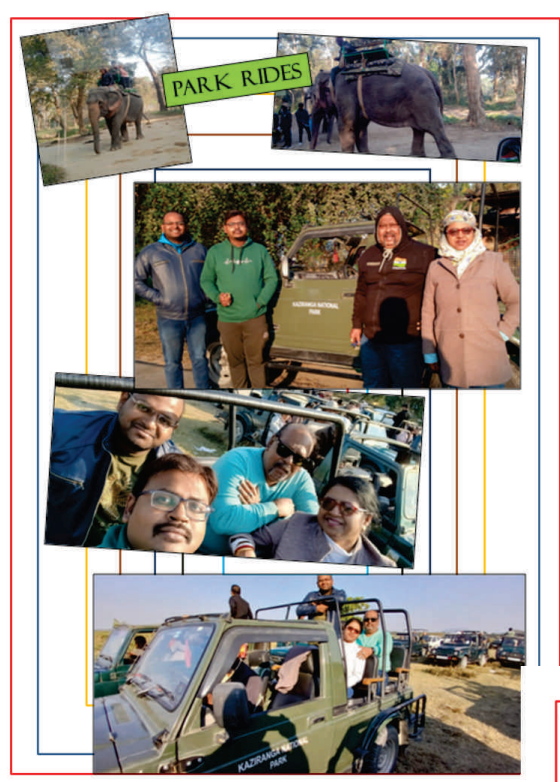
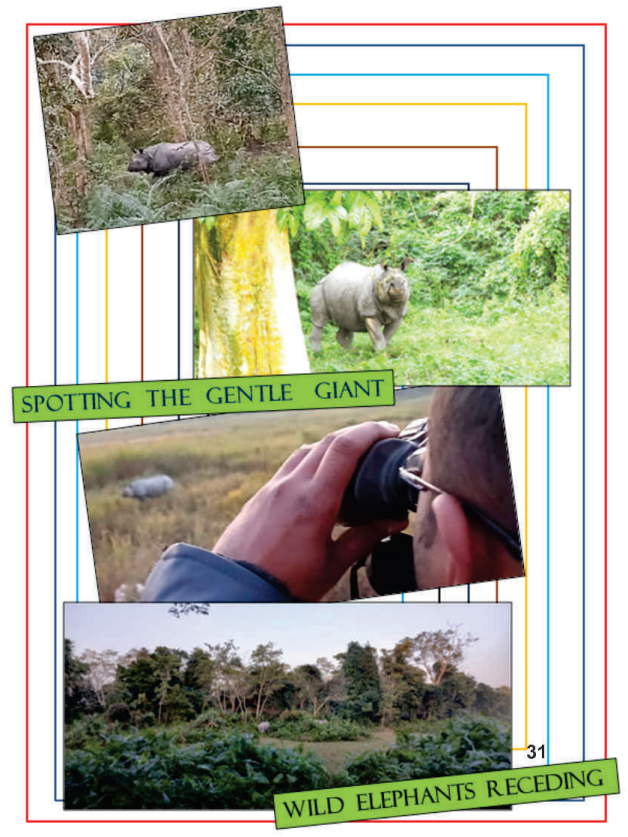
Eventually, on the edge of a large water body, we came across a solitary water buffalo. It was at some distance but gave us a clear view of the giant sweeping horns. Our cameras were inadequate but Biju obliged with a close up photo. We are not enthusiastic ornithologists but Biju was busy clicking birds; on the ground, on branches & in their roost.
Soon it was time for our exit. We were slightly emotional as we were bidding farewell to one of the best parks in the world. The immense serenity of the marshy terrain with water bodies, bushes, grasslands rolling off into the distant foothills leave an indelible imprint on one’s mind & soul. They forever remain the stuff for nostalgia in retrospect.
After our exit we made a beeline for the souvenir shop. We picked up caps, hats, t-shirts, badges, crockery & jackets all marked as ‘One Horn Nation’ & ‘Kaziranga National Park.’ We were met by Rajiv & his Innova & we parted ways with Biju with promises to distinctly chilly evening our hostess had set up a fireplace there, which was very welcome indeed. We ordered some potato & onion fritters to go with the flask-full of hot tea. Dinner was a quiet graceful affair in which two varieties of lentils & a mixed vegetable dish were served with rice. The country chicken curry was delicately spiced & all summed up to a very sumptuous meal.
Over cups of Assam tea we all spruced up in the morning after a well needed sleep & waited for our guide, Biju,. We had packed our bags & asked the Innova driver Rajiv, to meets us at the farther gate. From there we would commence our return journey after exiting from the morning ride.
Five hundred meters in the park we came upon two rhino at a distance of about seventy metres but in perfect broad-side-on position for sighting. Moving ahead we came across more rhino but much closer this time. Their grand profiles were showing the details of their anatomy & it was sheer ecstasy to view them. We spent a good twenty minutes in their company & reluctantly moved on as we were also on the lookout for the wild water buffalo & the elusive tiger. We came across several hog-deer & a sambhar stay in touch & even plan a visit again.
On our return to Guwahati both our families had much to talk about. We were in chance to meet Col. Sen’s son, Dr Robin a dental & maxillo-facial expert. He & wife Geetanjali had dropped down from Faridabad to attend Diljeet Dosanjh’s concert at Guwahati. Col. Sen & I slipped out for a visit to the Army Golf club. The lush green lawns with well cropped hedges & plants were really beautiful. In the far distance the golf lawns fringed the forest line.
We could make out rolled up barbed wire fences. They were placed because there had been incidents of wild elephants straying onto the lawns. The bar was well stocked & had seating in the verandah hallway. In addition they had a tree-top sit out area & one extending deeper into the course. The snacks were delectable with peppered fish being the specialty of the evening. We returned home where our hostess Mrs Mona had an excellent spread for us.
Nilachal hills, just off Guwahati is a very special place indeed; a must for tourists & those looking for a rare pilgrimage site. The hills are said to house numerous caves where ‘Tantra’ ascetics practice their rituals. The most renowned & revered site on the Nilachal hills is the ‘Kamakhya’ temple, steeped in history, architectural wonder, myths & miracles. As legends would have it & described in certain ‘Puranas’, Devi Sati self immolated herself in her father Daksh’s ceremonial pyre, after Lord Shiva’s insult on being barred from the grand ‘Yagna’.
The grief stricken Lord Shiva carried the charred remains & began a terrifying dance, the ‘Tandava’ which threatened the very existence of the Universe. Anticipating devastating consequences Lord Vishnu in consultation with Lord Brahma severed the charred body into fifty one parts using the ‘Sudarshan Chakra’. Each part fell to the ground on a different location, to constitute the fifty one ‘Shaktipeeths’. Devi Sati’s private reproductive parts are supposed to have fallen here, making it one of the most pious & mythical of all ‘Shaktipeeths’.
A good roadway led to the temple & we managed to approach to a proximity just a few flights of stairs away from the main sanctum. Col Sen had arranged for V.I.P. passes for us & engaged the services of a senior pandit. On the way we collected mementoes & wore red headbands of ‘Jai Ma Kamakhya’. We were led by our pandit onto a wide waiting area after which we were required to assemble in a single file to lead to another seated waiting area. The premises were live with exited people not to miss out a few goats & rhesus monkeys. It was the peak vacation period & the temple was teeming with devotees.
After about spending a good four hours since we entered the temple we progressed through caged corridors to reach the outer wing of the sanctum, which housed gold deities of Kamakhya Devi & Kameshwar Dev. We were guided by the pandit to offer flowers here amidst sacred chants. Finally we were led into the main sanctum which is a stone cave below the outer sanctum. We were all aware of an unseen energy here as we in the cavern containing the private parts of the Devi etched in stone. The place was partly immersed in water which is said to be perennial, which never dries out nor overflows. There is no idol here & the mythical creation was partly covered with beds of flowers. We were encouraged to touch the magical water amongst more sacred chants.
A number of festivals are observed here mainly ‘Navratri’ and the ‘Ambubachi’, in the last week of June every year. The temple is closed for three days when during this period the Devi is supposed to menstruate. The water in the main sanctum turns red & even connected parts of the Bramhaputra assume a reddish colour. This is an extremely sensitive affair & I wish to refrain from making any comments whatsoever. It is best left to experts in mythology, ancient beliefs, natural formations & pure sciences.
After exiting the temple complex we headed for the top of Nilachal hills. Several watch-points had been made along the way & we stopped frequently to admire the lovely view. On the top of the hill is the ‘Bogola’ or ‘Bhuvaneshwar’ temple. The view on both sides of the hill is breath taking & we had a grand panoramic view of the great Brahmaputra River & Guwahati town beyond. After spending a relaxing hour we headed back home in anticipation of a well needed rest & plans of our Meghalaya visit tomorrow.
We were already aware that Meghalaya was created in ’72 by separating two districts from Assam, namely the ‘Khasi’or ‘Jaintia’ hills & the ‘Garo’ hills. Over an early breakfast of buttered toast, scrambled eggs & cheese, Col Sen discussed the British influence & the military significance of the region. The Eastern Command of the Indian Air Force is based here & played a vital role in the Chinese war of ’62 & the Bangladesh liberation war of ’71. The British regarded the capital Shillong as the ‘Scotland of the east’ & it still has a distinct cosmopolitan touch. All festivals are celebrated here with zeal & the city also hosts a diverse range of cuisines. We were put into a good mood as we set of to explore the abode of the clouds, Meghalaya.
We were on a time count as we were to board the Brahmaputra river cruise later this evening, so were set our sights on three places; the well maintained ‘Hydari’ Park, the famed Elephant falls & of course the Shillong peak. Wide winding roads gradually gained altitude as we approached the Shillong peak. High in the roadways were numerous viewpoints from where the scenic beauty was marvelous with clumps of clouds just lazily floating by. The panoramic views were mesmerizing & accorded a sense of serenity, peace & tranquility.
The Shillong peak is situated at a height of about two thousand metres & under control of the Indian Air Force. For security reasons we had to shift to local certified vehicles. For entry we had our identities verified by Adhaar cards, as foreign nationals are disallowed from entering the area. The peak itself had a large open area facilitating the car park. We could walk around the area to circumnavigate the peak which accorded a grand circular view of the deep & distant surroundings. Most notable was a glimpse of green veldts of neighbouring Bangladesh. Nearly the full city of Shillong could be seen from here, rolling off into the distant Himalayas.
The height of the peak was an excellent vantage point for the Indian Air Force which served the country both in times of peace & war. Having satiated our senses by the grand view, we were simply thrilled & in awe of the location.
We moved into the campus area where a stall offered traditional costumes on hire. We were exited at the idea & Krishna & I donned the costumes of a Meghalayan flower girl & a ‘Khasi’ warrior. We spent the next fifteen minutes posing for photographs captured by our smiling amused children. Reluctantly we were to return to the plains where we went onto visit the Hydari park which well maintained but would fully blossom during the spring.
The Elephant falls was next on the itinerary & on reaching were welcomed by the sound of unseen waterfalls. A downward flight of a broad stairway bought the falls into view. The falls was aptly named as the streams of water fell on a giant rock which resembled an elephant’s back. I acquired a mini bow & a quiver with arrows as a memento. Pressed for time we had a scratch meal of fried chiken, Singapore rice, steamed momos & rushed back to Guwahati in time for the Bramhaputra cruise. Unfortunately only Krishna & Vijay could join Mrs & Col Sen, as elder son Raja & I had to leave for some urgent shopping.
After a restful sleep we were to undertake the first leg of our return early in the morning. We profusely thanked our hosts with warm embraces & hugs, with promises to catch up in ’25 at Jabalpur during the Dussehra festival. As we were going in the same direction we dropped Raja at the airport for his return flight to Pune. We managed a good time on the highway avoiding the under-construction segment & were in time for dinner at Siliguri. This time my maternal in-law aunt & their family had invited us. Dinner was a grand affair with mustard ‘Papda’ fish, fried lobsters with ‘Pulao’ & mutton curry, with two varieties of sweets. Later amidst ‘pranams’ & good wishes, we packed up ‘Bay leaves’ & ‘cinnamon’ bark from their garden which had already been picked for us, & reached my in-law uncle & aunt’s for the night’s bunking.
Due to some communication gap my in-law aunt had prepared fish curry for dinner the previous night. She dried out the curry & packed it for our onward journey. We packed it in our food basket & kept it in the rear seat, lest it jostle on bumpy roads. We broke for lunch at a decent ‘dhaba’, ordered some chicken & ‘tava rotis’ & had a fulfilling lunch including our packed fish.
We had planned to stay overnight at Chhapra to commence our last leg to Jabalpur tomorrow. It was New Year’s Eve & we reached Chhapra at about five thirty. We had covered a good four hundred & fifty kms but it was still too early to retire. In consultation with our cabbie Hemant it was decided to make a dash to Varanasi, a distance of approx two hundred & fifty kms. Varanasi apart from being a most holy city, was also the residence of my maternal grandparents, uncles & aunts, but now only occupied by my cousin, his wife & some tenants, their sons being away at Mumbai.
My cousins were pleasantly surprised by this chance visit & enthusiastically awaited our arrival. As we entered the fringes of Varanasi it became obvious the New Year’s celebrations were in full swing. The major streets were vibrant with lights & colourful motifs. Hotels & restaurants were extravagantly decorated & well dressed waiters wooed the multitude on the streets. The branded showrooms & major stores were prominently on display by balloons, paper cuttings & ribbons. Flower stalls had sprung up selling bouquets & roses, garlands, headbands, wrist-bands, hats & stuff that festivities comprise of. Blaring music could be heard on all sides & the city was in a full-on gaiety mood.
Traffic was diverted at numerous places & we finally reached our destination on Luxa road situated just two squares away from the Kashi Vishwanath temple. After ‘pranams’ & pleasantries exchanged we were led to the dining area where my cousins had ordered a special meal for us. At the stroke of midnight heralding the New Year, we delved into a most delicious combination of ‘biriyani’ with ‘kababs’, amidst the burst of firecrackers outside on the streets.
Varanasi was very special to my wife & me. She a B.H.U. alumnus, having stayed at the ‘Rajghat’ hostel on the banks of the Ganga, had many treasured memories of the city. I had spent nearly all my winter holidays at my maternal uncle’s house, ‘Taruchhaya’, at Luxa road. During my childhood the household was a buzz of excitement where uncles, aunts, cousins & friendly neighbours talked nineteen to a dozen, amidst much laughter & gaiety. Later a quartet would assemble including my dad, to play ‘Bridge’. My birthday was celebrated with much fervor & I used to be overjoyed on receiving a number of gifts, namely toys, books & new clothes.
‘Taruchhaya’, a palatial bungalow, was built in 1935 by my grandfather Capt Dr J.M. Gupta who had served in the First World War. It was dedicated to my grandmother ‘Tarubala’ & was designed reflecting the Renaissance period of architecture. The grand old lady still stands iconically on Luxa road, with its impressive galleries & stairways, crimson floors & banisters, cozy bedrooms & dining area, even a small library. Notable are the spacious balconies, exquisite mantle pieces and history reflected in portraits, not to forget the grand arches, & distinctive railings.
We had a traditional breakfast of Varanasi’s special ‘kachauris’ served with potato curry, & a layered sweet with a clove in the centre, best known as ‘labang latika’. We departed from ‘Taruchhaya’ after ‘pranams’ & getting a tearful farewell from our cousins & the Mukherjis, our neighbours of many a decade. We were disappointed at seeing the swollen crowds at the ‘Kashi Vishwanath’ & ‘Santakmochan’ temples, which we hoped to visit but would take the entire day in the process. Regretfully we started the final leg of our journey homewards. There was a trance-like quiet in the car as we all dwelt on our experiences of the last week.
After Mirzapur we crossed Hanumana & entered our home state to reach Maihar following Rewa. We halted at Maihar for lunch at the Indian Coffee House, which is much respected for its quality at all outlets throughout the state. We made a final coffee break just on the outskirts of Jabalpur & reached home at about six-o-clock. The silent stress & strain of the past few days were now taking toll & with leaden feet & stiff bodies we somehow unloaded our luggage. We bid farewell to our cabbie, Hemant, & on entering our house we all thanked the almighty for a safe, comfortable, pleasurable & fruitful journey.


